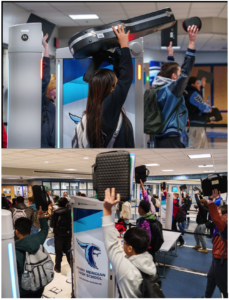The Indianapolis Star ran a story last week on some school districts betting on artificial intelligence (AI) weapons detection systems as the future of school security. I spoke with the reporter at length when she was working on the story, and she captured my concerns in her story about fidelity of implementation issues and the risks for creating security theater. She also captured the significance of student reporting of incidents and the value of school staff relationships with students and the school community. (Learn more here from the full story: https://www.indystar.com/story/news/education/2024/03/12/ai-weapons-detection-devices-used-for-security-in-more-indiana-schools/71851540007/)
Students forced to carry Chromebooks, musical instruments cases, and other “weapons of mass instruction” into school over their heads creates fidelity of implementation, “security theater” concerns

But it was these two pictures from the story that quickly grabbed my attention. The most obvious question asked by everyone I showed the pictures to, including some kids, was whether student cases with Chromebooks, musical instrument cases, and cases for other items carried in by students over their heads and above the weapons detection system were going to be searched by school staff to check their contents.
“How do they know that kids aren’t carrying in weapons inside the musical instrument cases, Chromebook cases, and other carriers students are holding over the scanners,” I was repeatedly asked.
That’s a great question. Are school staff really going through to check each and every one of the hundreds of cases they bring in each day carried over the detection systems? I seriously doubt it.
Should students, teachers, and parents be worried? Yes and no. Most students will only bring in Chromebooks, spiral notebooks, water bottles, eyeglass cases, musical instruments and other day-to-day items that set off false alarms from the “high tech” weapons detection.
But it only takes one student to defeat these systems that schools spend millions of dollars for by walking through with their hands over their heads. I have already had one school security official tell me about a student who went through a similar system, only to be found later in the day with a gun in school. He admitted that it was carried in over his head with the other items, according to the safety officer.
This raises serious issues around the fidelity of implementation of these expensive weapons detection systems. It also validates concerns that these may create “security theater,” the perception of increased security, and may directly or indirectly overpromise heightened security to students, staff and parents.
Will student high school memories be engrained with images of their being forced to walk into school each day with their hands in the air? Does it create unintended consequences of heightening student safety fears?
Many parents and students are asking if having to walk like prisoner robots with their hands in the air and carrying multiple items that set of false alarms is the best investment of limited resources. Also, is it the lasting memory we want kids to have of their high school experience?
Additionally, does the actual level of risk warrant this allocation of dollars, staff time and impact on students? Many school security professionals worry that these expenditures are not being made based upon a comprehensive assessment of school security threats and vulnerabilities. While we know that one schooting or gun in a school is one too many, we also know that school shootings are high-impact but low-probability occurrences and there are many other day-to-day security threats that are much more likely to occur.
 Emerging research studies also point to decreased student perceptions of safety in their schools that have heavy physical security measures such as weapons screening. On the surface, this may be counterintuitive: How can more security hardware and tech make people feel less safe?
Emerging research studies also point to decreased student perceptions of safety in their schools that have heavy physical security measures such as weapons screening. On the surface, this may be counterintuitive: How can more security hardware and tech make people feel less safe?
But we spoke with a focus of group of students during a security and emergency preparedness assessment consultation recently where the topic of weapons screening came up. They were asked a simple open-ended question: What do you think about metal detection or other weapons screening?
While some initially thought it might be a good idea, several students questioned it with one young lady saying, “If I would see that the first thing I walked in the door, I would be asking myself if I want to be here if the place is that bad that they need all these metal detectors.” Several other students chimed in saying they had not yet thought it about it that way.
My lesson learned from the conversation: Maybe the research is on to something. We need to dig deeper on the “unintended consequences” that arise when we introduce new security measures in child-oriented settings.
For now, one thing is clear: The students are in over their heads – literally – carrying everyday common school items up in the air in order to get into their schools with new, expensive weapons screening systems.
And a growing number of incidents and issues suggest school administrators may be in over their heads, too.
Dr. Kenneth S. Trump is President of National School Safety and Security Services
National School Safety and Security Services
Experts You Can Trust!
Connect with Dr. Ken on Linkedin: www.linkedin.com/in/kentrump/
Follow Dr. Ken on Twitter @safeschools
Visit and “Like” Our Facebook School Safety News Channel at: www.facebook.com/schoolsafety
Visit School Security Blog at: www.schoolsecurity.org/blog

